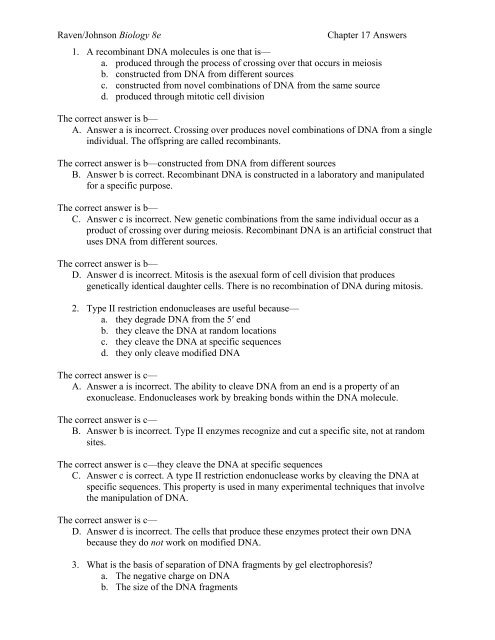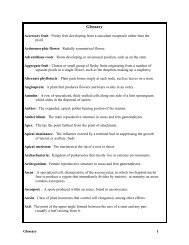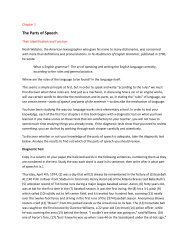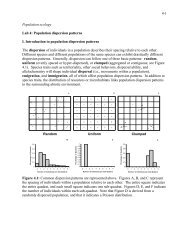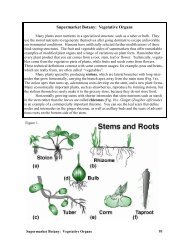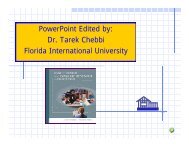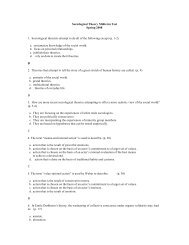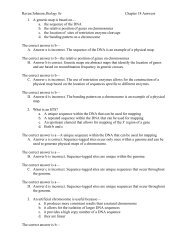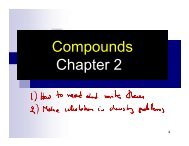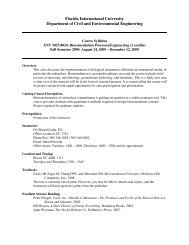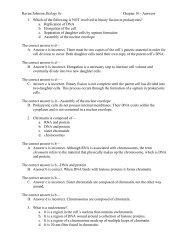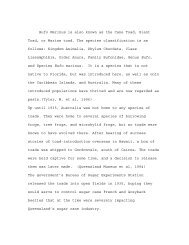Raven/Johnson Biology 8e Chapter 17 Answers 1. A recombinant ...
Raven/Johnson Biology 8e Chapter 17 Answers 1. A recombinant ...
Raven/Johnson Biology 8e Chapter 17 Answers 1. A recombinant ...
Create successful ePaper yourself
Turn your PDF publications into a flip-book with our unique Google optimized e-Paper software.
<strong>Raven</strong>/<strong>Johnson</strong> <strong>Biology</strong> <strong>8e</strong><strong>Chapter</strong> <strong>17</strong> <strong>Answers</strong><strong>1.</strong> A <strong>recombinant</strong> DNA molecules is one that is—a. produced through the process of crossing over that occurs in meiosisb. constructed from DNA from different sourcesc. constructed from novel combinations of DNA from the same sourced. produced through mitotic cell divisionThe correct answer is b—A. Answer a is incorrect. Crossing over produces novel combinations of DNA from a singleindividual. The offspring are called <strong>recombinant</strong>s.The correct answer is b—constructed from DNA from different sourcesB. Answer b is correct. Recombinant DNA is constructed in a laboratory and manipulatedfor a specific purpose.The correct answer is b—C. Answer c is incorrect. New genetic combinations from the same individual occur as aproduct of crossing over during meiosis. Recombinant DNA is an artificial construct thatuses DNA from different sources.The correct answer is b—D. Answer d is incorrect. Mitosis is the asexual form of cell division that producesgenetically identical daughter cells. There is no recombination of DNA during mitosis.2. Type II restriction endonucleases are useful because—a. they degrade DNA from the 5′ endb. they cleave the DNA at random locationsc. they cleave the DNA at specific sequencesd. they only cleave modified DNAThe correct answer is c—A. Answer a is incorrect. The ability to cleave DNA from an end is a property of anexonuclease. Endonucleases work by breaking bonds within the DNA molecule.The correct answer is c—B. Answer b is incorrect. Type II enzymes recognize and cut a specific site, not at randomsites.The correct answer is c—they cleave the DNA at specific sequencesC. Answer c is correct. A type II restriction endonuclease works by cleaving the DNA atspecific sequences. This property is used in many experimental techniques that involvethe manipulation of DNA.The correct answer is c—D. Answer d is incorrect. The cells that produce these enzymes protect their own DNAbecause they do not work on modified DNA.3. What is the basis of separation of DNA fragments by gel electrophoresis?a. The negative charge on DNAb. The size of the DNA fragments
<strong>Raven</strong>/<strong>Johnson</strong> <strong>Biology</strong> <strong>8e</strong>c. The sequence of the fragmentsd. The presence of a dye<strong>Chapter</strong> <strong>17</strong> <strong>Answers</strong>The correct answer is b—A. Answer a is incorrect. The negative charge is necessary to cause the movement of theDNA fragments through the gel.The correct answer is b—The size of the DNA fragmentsB. Answer b is correct. Different size fragments move at different speeds with smallfragments moving more quickly than larger fragments.The correct answer is b—C. Answer c is incorrect. The sequence of the fragments does not contribute to theseparation.The correct answer is b—D. Answer d is incorrect. Dyes are used to visualize the fragments, but they do not contributeto the separation.4. How is the gene for β-galactosidase used in the construction of a plasmid?a. The gene is a promoter that is sensitive to the presence of the sugar, galactose.b. It is an origin of replication.c. It is a cloning site.d. It is a marker for insertion of DNA.The correct answer is d—A. Answer a is incorrect. Promoters are binding sites for RNA polymerase.The correct answer is d—B. Answer b is incorrect. Beta-galactosidase is an enzyme not an origin of replication.The correct answer is d—C. Answer c is incorrect. The gene for β-galactosidase is located in cloning sites, but is notitself a cloning site.The correct answer is d—It is a marker for insertion of DNA.D. Answer d is correct. When DNA is inserted into the plasmid, the function of this enzymeis disrupted. The absence of color formation is a marker for recombination.5. The basic logic of enzymatic DNA sequencing is to produce—a. a nested set of DNA fragments produced by restriction enzymesb. a nested set of DNA fragments that each begin with different basesc. primers to allow PCR amplification of the region between the primersd. a nested set of DNA fragments that end with known basesThe correct answer is d—A. Answer a is incorrect. Restriction enzymes cut specific sites but not frequently enough toallow sequencing.
<strong>Raven</strong>/<strong>Johnson</strong> <strong>Biology</strong> <strong>8e</strong><strong>Chapter</strong> <strong>17</strong> <strong>Answers</strong>The correct answer is d—B. Answer b is incorrect. It is important during enzymatic sequencing that the fragments allbegin from the same primer, because they are then terminated at different bases.The correct answer is d—C. Answer c is incorrect. PCR amplification is now used for sequencing, but the logic stillrequires generating a nested set of fragments that end with the same base.The correct answer is d—a nested set of DNA fragments that end with known basesD. Answer d is correct. The logic still requires generating a nested set of fragments that endwith the same base. This is accomplished using nucleotides that act as chain terminators.6. A DNA library is—a. an orderly array of all the genes within an organismb. a collection of vectorsc. the collection of plasmids found within a single E. colid. a collection of DNA fragments representing the entire genome of an organismThe correct answer is d—A. Answer a is incorrect. Genomic libraries are made up of random fragments of DNA fromthe entire genome, not just genes.The correct answer is d—B. Answer b is incorrect. A library is a collection of vectors with DNA inserted into them.The correct answer is d—C. Answer c is incorrect. Multiple cells are required to hold all the vectors that carry thevarious DNA inserts that make up a genomic library.The correct answer is d—a collection of DNA fragments representing the entire genome of anorganismD. Answer d is correct. A genomic library is a collection of random DNA fragments from theentire genome.7. Molecular hybridization is used to—a. generate cDNA from mRNAb. introduce a vector into a bacterial cellc. screen a DNA libraryd. introduce mutations into genesThe correct answer is c—A. Answer a is incorrect. The enzyme reverse transcriptase is used to make cDNA frommRNA.The correct answer is c—B. Answer b is incorrect. Molecular hybridization refers to the ability of a labeled probe tobind to its complementary sequence in denatured DNA.The correct answer is c—screen a DNA library
<strong>Raven</strong>/<strong>Johnson</strong> <strong>Biology</strong> <strong>8e</strong><strong>Chapter</strong> <strong>17</strong> <strong>Answers</strong>C. Answer c is correct. Molecular hybridization refers to the ability of a labeled probe tobind to its complementary sequence in denatured DNA. This property is used to identifythe presence of genes of interest within large DNA collections like libraries.The correct answer is c—D. Answer d is incorrect. Molecular hybridization refers to the ability of a labeled probe tobind to its complementary sequence in denatured DNA.8. The enzyme used in the polymerase chain reaction is—a. a restriction endonucleaseb. heat-resistant RNA polymerasec. reverse transcriptased. a heat-resistant DNA polymeraseThe correct answer is d—A. Answer a is incorrect. Restriction endonucleases are used to break up DNA. They are notpart of the polymerase chain reaction.The correct answer is d—B. Answer b is incorrect. PCR generates DNA fragments, not RNA.The correct answer is d—C. Answer c is incorrect. Reverse transcriptase is used to convert RNA into DNA. PCR usesDNA as its template.The correct answer is d—a heat-resistant DNA polymeraseD. Answer d is correct. PCR synthesizes DNA strands from a DNA template. The specificenzyme used, Taq polymerase, needs to be heat-resistant because the reaction cyclesthrough high- and low-temperature phases.9. How does the yeast two-hybrid system detect protein–protein interactions?a. Binding of fusion partners triggers a signal cascade that alters gene expression.b. Fusion partners are detected using radioactive probes of Western blots.c. Protein–protein binding of fusion partners triggers expression of a reporter gene.d. Protein–protein binding of fusion partners triggers expression of the Gal4 gene.The correct answer is c—A. Answer a is incorrect. The fusion partners are two parts of the Gal4 transcriptionalactivator. No signal cascade is involved.The correct answer is c—B. Answer b is incorrect. The fusion partners are two parts of the transcriptional activator,Gal4. Gal4 activity results in a change in gene expression.The correct answer is c—Protein–protein binding of fusion partners triggers expression of areporter gene.C. Answer c is correct. If the fusion partners can bind, then Gal4 becomes functional andwill trigger the expression of a reporter gene linked to the Gal4 promoter.
<strong>Raven</strong>/<strong>Johnson</strong> <strong>Biology</strong> <strong>8e</strong><strong>Chapter</strong> <strong>17</strong> <strong>Answers</strong>The correct answer is c—D. Answer d is incorrect. The fusion partners are hybrid proteins linking part of the Gal4transcription activator with a protein of interest. Fusion partner binding triggersexpression of a gene downstream from the Gal4 promoter.10. In vitro mutagenesis is used to—a. produce large quantities of mutant proteinsb. create mutations at specific sites within a genec. create random mutations within multiple genesd. create organisms that carry foreign genesThe correct answer is b—A. Answer a is incorrect. The production of large quantities of proteins is made possible byexpression vectors.The correct answer is b—create mutations at specific sites within a geneB. Answer b is correct. Scientists use in vitro mutagenesis to examine the effect of specificchanges in gene sequence of the function of the protein product.The correct answer is b—C. Answer c is incorrect. In vitro mutagenesis allows for the generation of known mutations.The correct answer is b—D. Answer d is incorrect. Transgenic organisms carry foreign genes.1<strong>1.</strong> Insertion of a gene for a surface protein from a medically important virus such as herpesinto a harmless virus is an example of—a. a DNA vaccineb. reverse geneticsc. gene therapyd. a subunit vaccineThe correct answer is d—A. Answer a is incorrect. A DNA vaccine is based on splicing an internal protein into aplasmid to trigger a cellular immune response.The correct answer is d—B. Answer b is incorrect. Reverse genetics refers to the use of genetic knockouts to examinethe role of a specific gene.The correct answer is d—C. Answer c is incorrect. Gene therapy involves the integration of a functional gene into anorganism to replace or repair an existing genetic mutation.The correct answer is d—a subunit vaccineD. Answer d is correct. Subunit vaccines are based on packaging a gene for a unique markerprotein for a pathogenic virus within a nonpathogenic virus which protects the individualby priming the immune response without exposing the person to the dangerous virus.
<strong>Raven</strong>/<strong>Johnson</strong> <strong>Biology</strong> <strong>8e</strong><strong>Chapter</strong> <strong>17</strong> <strong>Answers</strong>12. What is a Ti plasmid?a. A vector that can transfer <strong>recombinant</strong> genes into plant genomesb. A vector that can be used to produce <strong>recombinant</strong> proteins in yeastc. A vector that is specific to cereal plants like rice and cornd. A vector that is specific to embryonic stem cellsThe correct answer is a—A vector that can transfer <strong>recombinant</strong> genes into plant genomesA. Answer a is correct. The Ti plasmid can trigger the integration of the genes within theplasmid into a plant cell’s chromosome. In this way all the cells that arise from thetransfected cell will carry the <strong>recombinant</strong> protein.The correct answer is a—B. Answer b is incorrect. The Ti plasmid is specific to the plant bacteria Agrobacterium.The correct answer is a—C. Answer c is incorrect. The Ti plasmid normally does not transfecting cereal plants. It hasnow been modified to allow use with cereals.The correct answer is a—D. Answer d is incorrect. The Ti plasmid is specific for plants.13. Which of the following is NOT a possible benefit of genetically modified crops?a. Increased nutritional value for peopleb. Enhanced resistance to insect pestsc. Enhanced resistance to broad spectrum herbicidesd. Enhanced resistance to insecticidesThe correct answer is d—A. Answer a is incorrect. Golden Rice is an example of a genetically modified crop withimproved nutritional properties for humans.The correct answer is d—B. Answer b is incorrect. Bt crops are genetically modified to produce insecticidal proteins.The correct answer is d—C. Answer c is incorrect. Crops genetically engineered to overexpress EPSP synthase are anexample of a plant that will resist herbicides.The correct answer is d—Enhanced resistance to insecticidesD. Answer d is correct. Plants do not have to resist insecticides.Challenge Questions<strong>1.</strong> Many human proteins, such as hemoglobin, are only functional as an assembly ofmultiple subunits. Assembly of these functional units occurs within the endoplasmicreticulum and Golgi apparatus of a eukaryotic cell. Discuss what limitations, if any,exist to the large-scale production of genetically engineered hemoglobin.
<strong>Raven</strong>/<strong>Johnson</strong> <strong>Biology</strong> <strong>8e</strong><strong>Chapter</strong> <strong>17</strong> <strong>Answers</strong>Answer—Genetic engineering often means insertion of a gene of interest (and harvest of theprotein of interest) from vast numbers of bacterial cells. Bacteria are prokaryotes, and as such donot have internal membrane systems like the endoplasmic reticulum and Golgi apparatus. Analternative would be to use a yeast system since yeast cells are eukaryotes. In either case, one ofthe major limiting factors is the ability to efficiently harvest the protein of interest and purify itaway from all the other proteins normally produced by the host cell.2. Enzymatic sequencing of a short strand of DNA was completed usingdideoxynucleotides. Use the gel shown to determine the sequence of that DNA.G C A TAnswer—Read the gel starting from the smallest fragment (at the bottom) to the largest. Thesequence is: CTGATAGTCAGCTG


